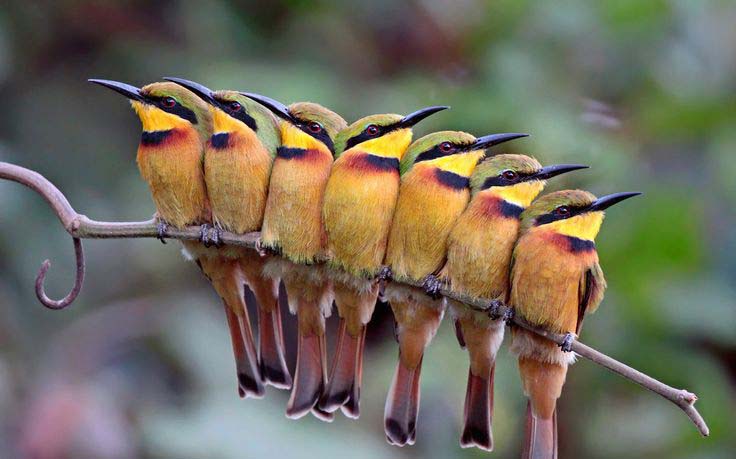Ethiopia is a country with greatly extraordinary diverse landscape situated in the Horn of Africa that bisects the country diagonally, Northwest and Southeast Mountainous Massifs by the Great Rift Valley. From the Palearctic autumn to spring (September to April) Ethiopia’s avifauna is vastly supplemented by migrants, many of them guided by the Great Rift Valley. Ethiopia is also much easiest part of the Horn of Africa to stay or to visit, and Ornithological appealing country, birding in its rich and unique flora and fauna is truly exceptional and joyful.
| DEPARTURE/RETURN CITY | Addis Abeba | |||||||||||
| DEPARTURE LOCATION | From Your Hotel/Airport | |||||||||||
| RETURN LOCATION | Your Hotel/Airport | |||||||||||
| ATWEAR | Comfortable athletic clothing, hiking boots, hat, jacket and sunscreen. | |||||||||||
| INCLUDED |
</table
|
|||||||||||
| NOT INCLUDED |
|
For most visitors to Ethiopia, it’s all about the north. More than anywhere else on Earth, northern Ethiopia has the ability to wow you day after day after day.
Day 1:
Arrive Addis Ababa, afternoon drive to Geferssa Reservoir. Here, we expect to see some of the endemic birds like the Wattle Ibis, Rouget’s Rail, black-headed Sis- kin, Abyssinian Long claw, the white collared pigeon and Blue-winged Goose. The African-black Duck, Ortolan bunting, Red-breasted Wheatear, Three-banded plover; African Marsh Harrier and African Fish Eagle are one of the species that we do see this afternoon. Overnight in hotel.
Day 2
Early start for Debre-Libanos monastery about 110 km north of the capital via Sululta Plain, the Red-rumpled and Lesser-striped Swallows, Pectoral-patched Cist cola, Abyssinian Ground Hornbill, common Buzzard and Black winged Lapwing are some of the birds that would be seen along the road. Around the monastery we expect to see some of the endemic birds like the Black-headed Forest Oriole, Banded Barbet, the White-billed Starling, Abyssinian Woodpecker, Rappel’s chat, the White-backed Black Tit and Abyssinian slaty Flycatcher. The Lammergeyers, Egyptian Vulture, Lanner Falcon, Verreaux’s Eagle and the White-checked Turaco are seen at the escarpment. Late afternoon drive back to Addis. Overnight in hotel.
Day 3
Leave Addis Ababa for Awash National Park, this morning we stop at Chalalklaka wetland near Debre-Zeit. The White-backed Duck, Tufted Duck, little stint, Ruff, African Spoon bill, Yellow billed stork, Common and crowned cranes, White-winged Black Tern and others are expect to be seen. Then we will have a short stop at lake Hora for more birding. Lunch will be at Nazareth. After lunch proceeding to Awash, one of the best birding sites in Ethiopian Rift valley. Overnight in hotel.
Day 4
Full day birding in the Park, The Arabian Bustard, Kori Bustard, White bellied Bustard, Buff crested Bustard, the Rosy-patched Shrike, Swallow tailed Kite, Bristle Crowned Starling, different woodpeckers, Grey-headed and Sulpher breasted Bush Shrike, Gabar Goshawk, Shirk, Crested Francolin, Common Quail, Harlequin Quail, Palm Swift, Orange-bellied Parrot, Martial Eagle, different wood Doves, Yellow billed Hornbill, Crested Lark, Singing Bush Lark, Red wing Bush Lark, Somali Golden-breasted Bunting, Little Rock Thrush, Grey-headed Batis and Spotted Flycatcher are one of the important birds that we are planning to see for today. Overnight in hotel.
Day 5
Drive to Langano, before lunch we will have short stops at Koka Dam (Awash River Bridge) for more aquatic and woodland birds. Then, we continue to Lake Zeway where we stop for lunch and an afternoon birding. Lake Zeway is one of the important areas of the Ethiopian Lakes. The Black Heron, Lesser Jacana, African Pygmy Goose, Pink backed and White Pelicans, Crowned Crane, Black-headed Gull, Great-black headed Gull, Verreaux’s Eagle Owl, Green Shank, Wood Sandpiper, common and African Snipe, Red breasted Wryneck, Masked Weavers, Beautiful Sunbird and some others would be seen. Overnight in hotel.
Day 6
Early birding around the Hotel garden and the cliff near the lake. Shallow’s Wheatear, Red bill and Von de Deckins Horn bill, Diedderik Cuckoo, Slender-tailed Nightjar, woodland Kingfisher, striped Kingfisher, Little and Blue-breasted Bee-eater, the endemic Black winged Love bird, Red-headed Weaver, Fan tailed Raven, Hemp Rich’s Hornbill, Brubru, Bearded Woodpecker, Bare faced Go away bird and Marico sunbird are one of the species we expect this morning. After breakfast we drive to the Abijata-Shalla lakes national park for more birding. The Saddle bill stork, Goliath Heron Golden Plover, Grassland pipit, lesser and Greater Flamingos, and hundreds of other water birds could be easily seen. Overnight in hotel.
Day 7
Full day birding in the forest of Wondo Genet, it is the site for some the endemic birds like the Yellow-fronted Parrot, Thick-billed Raven, the Abyssinian Wood pecker and Banded Barbet. In addition, We expect to see the Red -shouldered and Black Cuckoo shrikes, Grey Cuckoo shrike, Marin’s Trogon, White-checked Turaco, Double Toothed Barbet, Scaly and Lesser Honey guide, Crowned Eagle, Aria’s Hawk Eagle, Silvery checked Horn bill, Hadada Ibis, Banded Wattle eye, Sharpest starling, Broad billed Roller, Black billed Barbet, Lemon Dove, Mountain Buzzard and Half-collared Kingfisher. Overnight in hotel.
Day 8
set off for Lake Awassa. The spotted creeper, African pygmy kingfisher, Bruce’s Green pigeon, Violet-backed Starling, Grey Kestrel, Giant Kingfisher, Klaasa’s Cuckoo, Tree pipit, Allen’s Gallenue, Lesser Moorhen, Painted Snipe, Lesser Swamp Warbler, Grey kingfisher, Banded snake Eagle, the African and common snipe, purple and Goliath Heron, Greater Honey Guide, Grosbeak weaver, Red-breasted Wryneck, African Harrier Hawk and Greater spotted Eagle are one of the birds have been recorded in Awassa. Overnight in hotel.
Day 9
Drive back to Addis Ababa. En route looking for the species that haven’t been in the previous days of our trip, afternoon city tour in Addis Ababa. Overnight in hotel.
Day 10
Departure – Fly Back Home







Tour Reviews
There are no reviews yet.
Leave a Review